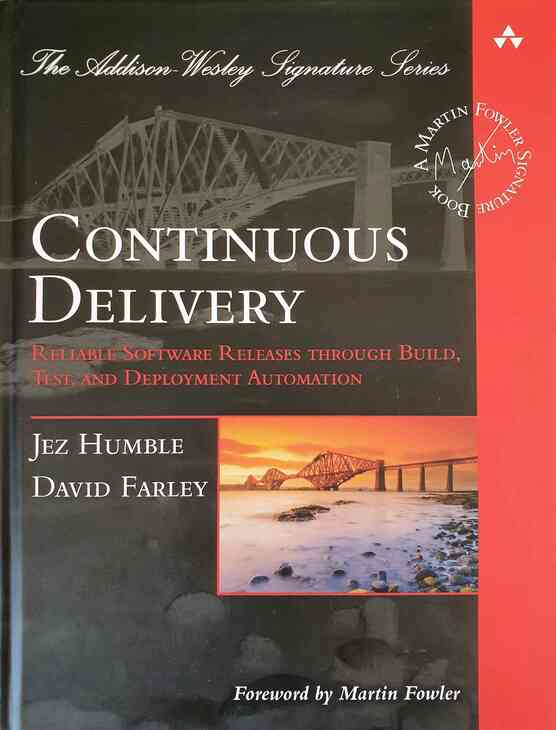Jez Humble and David Farley

A deployment pipeline is, in essence, an automated implementation of your application’s build, deploy, test, and release process. (Humble & Farley 2011, 3)
There should be two tasks for a human being to perform to deploy software into a development, test, or production environment: to pick the version and environment and to press the “deploy” button. (Humble & Farley 2011, 5-6)
A production environment should be completely locked down. It should not be possible for anybody to make a change to it without going through your organization’s change management process. (Humble & Farley 2011, 53)
Unit test should not involve calling the database, using the filesystem, talking to external systems, or, in general, interaction between components of a system. (Humble & Farley 2011, 89)
Software development is a naturally iterative process that thrives on the establishment of effective feedback loops, and we deceive ourselves if we perceive it any other way. (Humble & Farley 2011, 89)
… a deployment pipeline is an automated manifestation of your process for getting software from version control into the hands of your users. (Humble & Farley 2011, 106)
The binaries that get deployed into production should be exactly the same as those that went through the acceptance test process … (Humble & Farley 2011, 114)
Ultimately, you should only need to specify the target environment and the version of the application to initiate a successful deployment. (Humble & Farley 2011, 116)
With automated deployment and release, the process of delivery becomes democratized. (Humble & Farley 2011, 130)
It should be possible to deploy a single change to production through the deployment pipeline with the minimum possible time and ceremony. (Humble & Farley 2011, 131)
Acceptance tests fall into two types: functional and nonfunctional. (Humble & Farley 2011, 136)
Your deployment process should always leave the target environment in the same (correct) state, regardless of the state it finds it in when starting a deployment. (Humble & Farley 2011, 155)
Errors are the easiest to fix if they are detected early, close to the point where they were introduced. (Humble & Farley 2011, 171)
… running unit tests shouldn’t touch the filesystem, databases, libraries, frameworks, or external systems. (Humble & Farley 2011, 178)
This is the essential difference between mocking and stubbing - with stubs, we don’t care about how the stub is called; with mocks, we can verify that our code interacted with the mocks in the way we expected. (Humble & Farley 2011, 181-182)
The objective of acceptance tests is to prove that our application does what the customer meant it to, not that it works the way its programmers think it should. (Humble & Farley 2011, 188)
The ideal test should be atomic. (Humble & Farley 2011, 205)
…performance is a measure of the time taken to process a single transaction, and can be measured either in isolation or under load. Throughput is the number of transactions a system can process in a given timespan. It is always limited by some bottleneck in the system. The maximum throughput a system can sustain, for a given workload, while maintaining an acceptable response time for each individual request, is its capacity. (Humble & Farley 2011, 225)
… while in an ideal world everyone wants their systems to be highly secure, very high-performance, massively scalable, massively flexible, extremely scalable, easy to use, easy to support, and simple to develop and maintain, in reality every one of these characteristics comes at a cost. (Humble & Farley 2011, 227)
For seriously high-capacity and high-performance systems, the highest performance part of the whole system is, necessarily, the test, not the production code. (Humble & Farley 2011, 243)
In every system, there comes a moment when a critical defect is discovered and has to be fixed as soon as possible. In this situation, the most important thing to bear in mind is: Do not, under any circumstances, subvert your process. (Humble & Farley 2011, 265)
Deployment pipelines are all about creating a repeatable, reliable, automated system for getting changes into production as fast as possible. (Humble & Farley 2011, 267)
Production environments should be completely locked down, so that only your deployment pipeline can make changes to it. (Humble & Farley 2011, 273)
… development teams are incentivized to deliver software as rapidly as possible, whereas operations teams aim for stability. (Humble & Farley 2011, 279)
The deployment system forms an integral part of the application - it should be tested and refactored with the same care and attention as the rest of the application, and kept in version control. (Humble & Farley 2011, 283)
… the success of a project can often turn on its ability to be deployed cleanly and reliably. In our view, no technology can be considered genuinely enterprise-ready unless it is capable of being deployed and configured in an automated way (Humble & Farley 2011, 297)
… application developers need to make the IP addresses that their application listens on configurable at deploy time (Humble & Farley 2011, 302).
… it should be quicker to provision a new environment than debug and fix one that’s in an unknown state due to uncontrolled changes … (Humble & Farley 2011, 306)
The purpose of the deployment pipeline is to put every change you make to your application through your automated build, deploy, and test process to verify its fitness for release (Humble & Farley 2011, 308)
Logging, which is part of auditability, should be treated as a first-level set of requirements, the same as any other nonfunctional requirements (Humble & Farley 2011, 320)
Continuous integration demands that we are able to keep the application working after every change made to it. This includes changes to the structure or content of our data (Humble & Farley 2011, 327)
… the commonest problem that causes difficulty is changing the database schema. If such changes are additive, in that they create new relationships, you are mostly fine - unless you do things like adding constraints that existing data violates, or adding new objects without default values (Humble & Farley 2011, 329).
For database-related tests, we create a transaction at the beginning of the test, perform all of the operations and interactions with the database that we require within that transaction, and at the conclusion of the test (whether it passed or not), we roll back the transaction (Humble & Farley 2011, 337).
Continuous delivery provides the ability to release new, working version of your software several times a day. This means you have to keep your application releasable at all times (Humble & Farley 2011, 345).
When we talk about components, we mean a reasonably large-scale code structure within an application, with a well-defined API, that could potentially be swapped out for another implementation (Humble & Farley 2011, 345).
Organize teams by functional area rather than by component, ensure that everybody has the right to change any part of the codebase, rotate people between teams regularly, and ensure that there is good communication between teams (Humble & Farley 2011, 358).
… computing power is ultimately cheap compared to humans performing forensics (Humble & Farley 2011, 363).
The most important property of an artifact repository is that it should not contain anything that cannot be reproduced (Humble & Farley 2011, 373).

